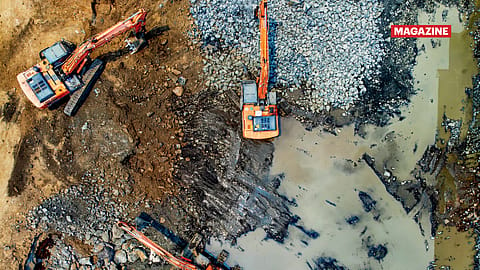China’s rare-earth curbs expose fault lines in India’s EV supply chain
China’s curbs on rare-earth element exports have hit India’s auto manufacturers hard. What lies ahead?

When Maruti Suzuki, India’s largest maker of passenger vehicles, reported its sales figures for May recently, the air was fraught with uncertainty. China’s tight curbs on the export of rare-earth elements—which came into effect in April—were ringing alarm bells across the Indian automobile industry.
Therefore, it did not come as a surprise when Rahul Bharti, executive director of corporate affairs at Maruti Suzuki, faced a barrage of questions on the runway the carmaker had before the disruption in the supply of rare-earth magnets began impacting production, especially that of the e-Vitara, its first battery electric vehicle (BEV) slated for a launch in September. The vehicle is pivotal to Suzuki’s ambitions of making India a production hub for BEVs. Bharti said the company will inform all stakeholders should there be any impact.
Barely 10 days later, reports emerged that Maruti Suzuki had slashed production targets of the e-Vitara by two-thirds in H1FY26. A significant portion of the vehicles had been earmarked for export to key markets, including Europe and Japan.
“If [this] happens, this is going to be a lot critical than the semiconductor crisis,” says Puneet Gupta, director, S&P Global Mobility. He explains that rare-earth magnets and minerals have widespread application in the automotive industry, including the catalytic convertors used in passenger vehicles. These magnets are valued for their efficiency and strength. They are also used in the motors of the power steering of both electric and ICE vehicles, and traction motors for BEVs. On the other hand, ferrite magnets—the small black ones usually seen in vehicles—are used for less performance-sensitive applications such as wiper motors, window regulators, and starter motors.
Shovik Banerjee, partner, Kearney, believes that automakers with an EV-heavy portfolio are more exposed to the disruption. “The rare-earth magnets are used in both electric and ICE vehicles, but the content used in the latter is considerably lesser,” he explains.
According to an Icra estimate, in FY25, India imported $200 million worth of these magnets for both automotive and non-automotive applications, with 85% coming from China. Arti Roy, associate director, CareEdge Ratings, says that India imported nearly 90% of its permanent magnets containing rare earth elements (REEs) from China in FY24 and FY25. China controls 70% of the supply of REEs and 90% of the processing of the REEs.
The disruption comes at a time when the domestic passenger vehicles market is expected to see low single-digit growth. Gupta feels that the domestic market runs the risk of de-growing this year if there is disruption in the supply of REEs. But Banerjee begs to differ. “Most of the automobile industry is currently ICE-heavy. There might be a dip in production for a quarter or two, but I don’t see a de-growth for sure.” He explains that the extent of disruption will also depend on the kind of strategic tie-ups OEMs have with suppliers. “The ones who don’t have that kind of strategic tie-ups with suppliers [will be hit], because it’s going to be about who gets priority first,” he says.
More Stories from this Issue
Hyundai Motor, for instance, reportedly has a stockpile of REEs that can last for about a year. It explains why Hyundai Motor India COO Tarun Garg said that the company does not face any impact from the shortage of REEs.
While Gupta believes that the government will be able to carry out a successful diplomatic intervention with China, the disruption has laid bare the over-dependence on Beijing, especially by India’s fledgling but growing BEV sector. Over the past five years ended FY25, EV sales surged to about 2.03 million units, with a CAGR of 63%. The growth has been led by electric two-wheelers, with an annual CAGR of 112%.
“In a way, it’s a wake-up call for all those who have become over-reliant on certain geographies. It’s a wake-up call for the whole world that you need trusted partners in your supply chain,” Union commerce minister Piyush Goyal said during his visit to Switzerland in June.
Despite the optimism in the industry, as of June 17, none of the export licence applications submitted by Indian firms for REEs had been approved by China.
(INR CR)
The long-term solution is for India to become self-reliant in the REE supply chain. For this, the government launched the National Critical Mineral Mission in June. Under this, the Geological Survey of India will conduct 1,200 new exploration projects in India from 2024-25 to 2030-31. A committee formed by the Ministry of Mines in November 2022 identified 30 critical minerals.
But, according to Banerjee, this is a long-term solution and will take years to fructify. Till then, forming strategic partnerships to secure REEs—and building up higher inventory—is the way to go.
